- June 25, 2014
- Posted by: BlueSkies
- Categories: Extreme Weather, Hazard Mitigation
Having grown up in Oklahoma, in the heart of Tornado Alley where annual violent twisters are just part of the springtime scenery, even I was initially a bit surprised when I heard of a new report out of the Southeast Regional Climate Center (SRCC) at the University of North Carolina. According to research by Charles Konrad II and his team at the University of North Carolina (UNC), the state in which tornadoes kill the most people per mile tracked on the ground is not Oklahoma or Kansas, not Texas or Arkansas or Mississippi – it’s Florida.
Now, Florida is no stranger to tornados. In fact, per square mile, Florida has more tornados than any other state in the country. But they’re usually not violent tornadoes – not like the EF5 monsters that ripped through Joplin, MO, in 2011 and through Moore, OK, in 1999 and 2013.

The vast majority of violent tornadoes are spawned by long-lived supercell thunderstorms, and weather patterns in Florida just don’t support those sorts of storms. Instead, Florida typically experiences weaker tornadoes, often spun up by interactions with the Gulf Coast and Atlantic sea breezes or by tropical cyclones. These tornadoes can cause substantial damage (e.g. roofs and siding removed, trees uprooted, cars flipped), but it’s not the sort of damage that one usually thinks of as causing widespread loss of life.
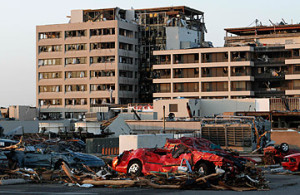
And therein lies the initial – but not necessarily warranted – surprise. When we think about risk, we tend to oversimplify the equation. We tend to assume that exposure = risk. We figure that the bigger, badder, and more frequent the hazard, the more people are likely to be harmed by it. By that reasoning, the southern Plains and the Deep South should have the deadliest tornadoes. Those are, after all, the regions of the country that experience the highest frequency of strong tornadoes. In other words, that’s where the greatest exposure per square mile is.
[column width=”six” position=”first”]
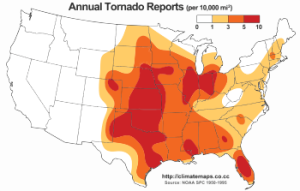
[/column]
[column width=”six” position=”last”]
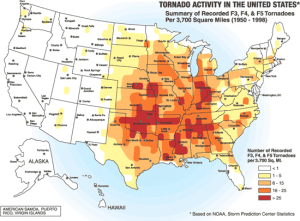
[/column]
But that’s not where the highest density of tornado-related deaths occur. According to Konrad and his team, that dubious honor – greatest number of deaths per mile along the track of a tornado – goes to Florida.
To understand why, we have to look at the real risk equation.
Risk = Exposure x Vulnerability
Exposure per square mile is only part of the story. Sure, you have to have tornadoes on the ground for people to be killed by them – but you also have to have people in the path of the tornado who lack the appropriate resources to protect themselves.
To understand why Florida’s risk for tornado deaths is so high, we can compare it another state with almost exactly the same average number of tornadoes per square mile: Kansas.
According to the SRCC study, the number of deaths per mile along tornado tracks is nearly five times higher in Florida than in Kansas. Yet, while Florida and Kansas experience almost the same number of total tornadoes per square mile, tornadoes in Kansas are, on average, stronger than in Florida.
[column width=”six” position=”first”]

[/column]
[column width=”six” position=”last”]

[/column]
So, why isn’t Kansas at the top of the list? The answer has to do with population density and population vulnerability.
The number of people in the path of the tornado is maximized when tornadoes form and track over populated areas. In Florida, tornadoes tend to cluster along the populous Atlantic coast and along a stretch of Intersate-4 from Tampa to Orlando.
The population density in these regions ranges from about 300 – 1000+ people per square mile. By contrast, only one county in Kansas has a population density above 1000 people per square mile, and the vast majority of the state has a population density below 50 people per square mile. In fact, the average population density of Florida is more than ten times greater than that of Kansas.
[column width=”six” position=”first”]
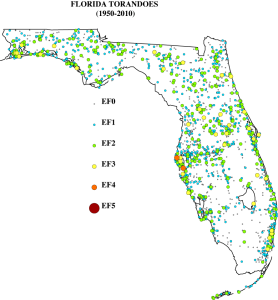
[/column]
[column width=”six” position=”last”]

[/column]
So, when a tornado touches down in Florida, it’s much more likely to encounter people along its path.
There are also a number of demographic factors that make Floridians more vulnerable to tornados than Kansans.
[checklist type=”dotted”]
- Florida lives up to its reputation as a retiree paradise. Florida ranks first in the country in the percentage of its population over the age of 60. Kansas ranks 17th. Older people, especially those in poor health, tend to be injured more easily and more severely than younger, healthier individuals.
- The geographically adjusted poverty rate is also 8% higher in Florida than in Kansas (due, largely, to the higher cost of living in Florida) . People living in poverty often live in housing that is less sturdy and offers less tornado protection than their middle-class counterparts.
- And finally, the climatology of Florida (and of the Southeast in general) results in a higher percentage of Florida tornadoes occurring at night, when tornadoes are harder to see and when people are less likely to receive warnings in time to take protective action.
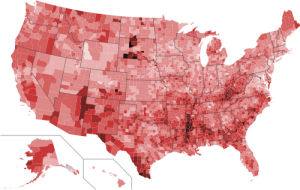
[/checklist]
This study out of UNC reminds us that risk assessment often has more to do with human systems and the built environment than with the natural hazards themselves. Risk exists in that intersection of exposure and vulnerability – exposure is largely a matter of where we live, while vulnerability is largely a matter of how we live. Effective risk mitigation requires understanding and addressing both.
Blue Skies Meteorological Services can help businesses identify their exposure and vulnerability to weather and climate impacts so that risks can be effectively targeted and reduced while resiliency is simultaneously built into operations.
